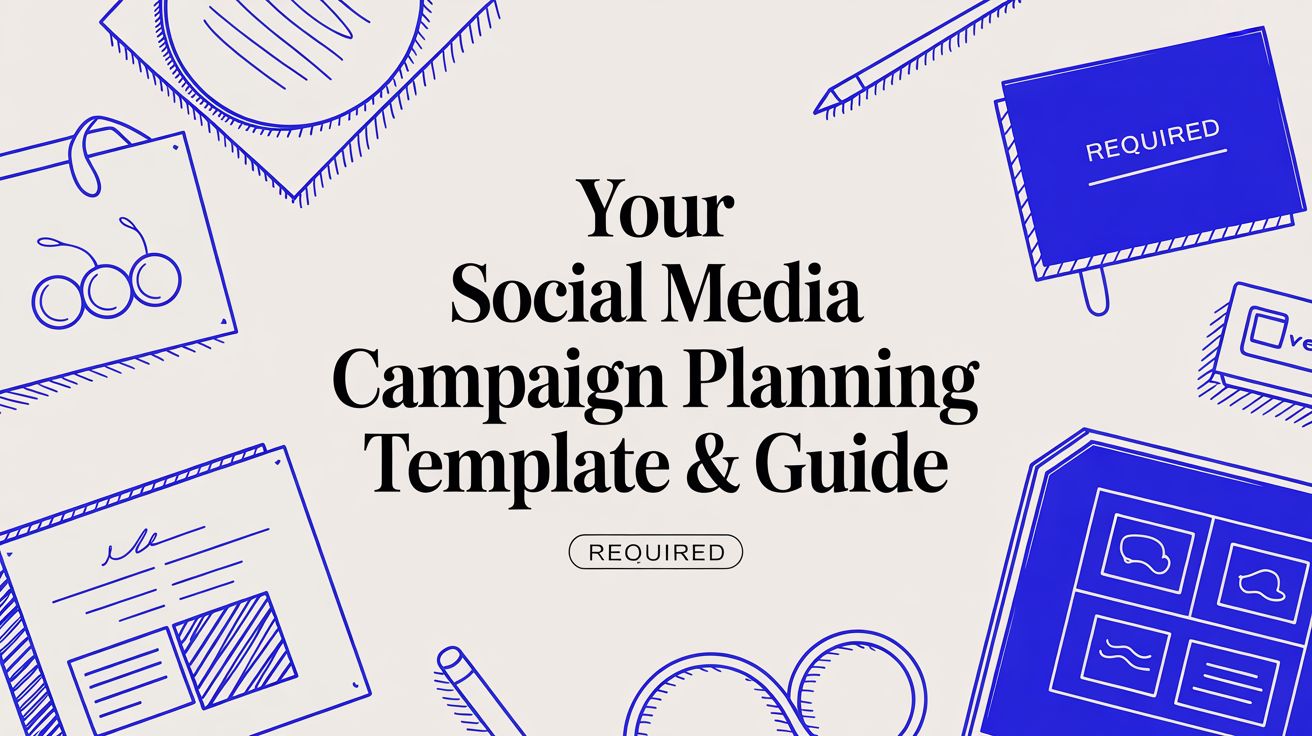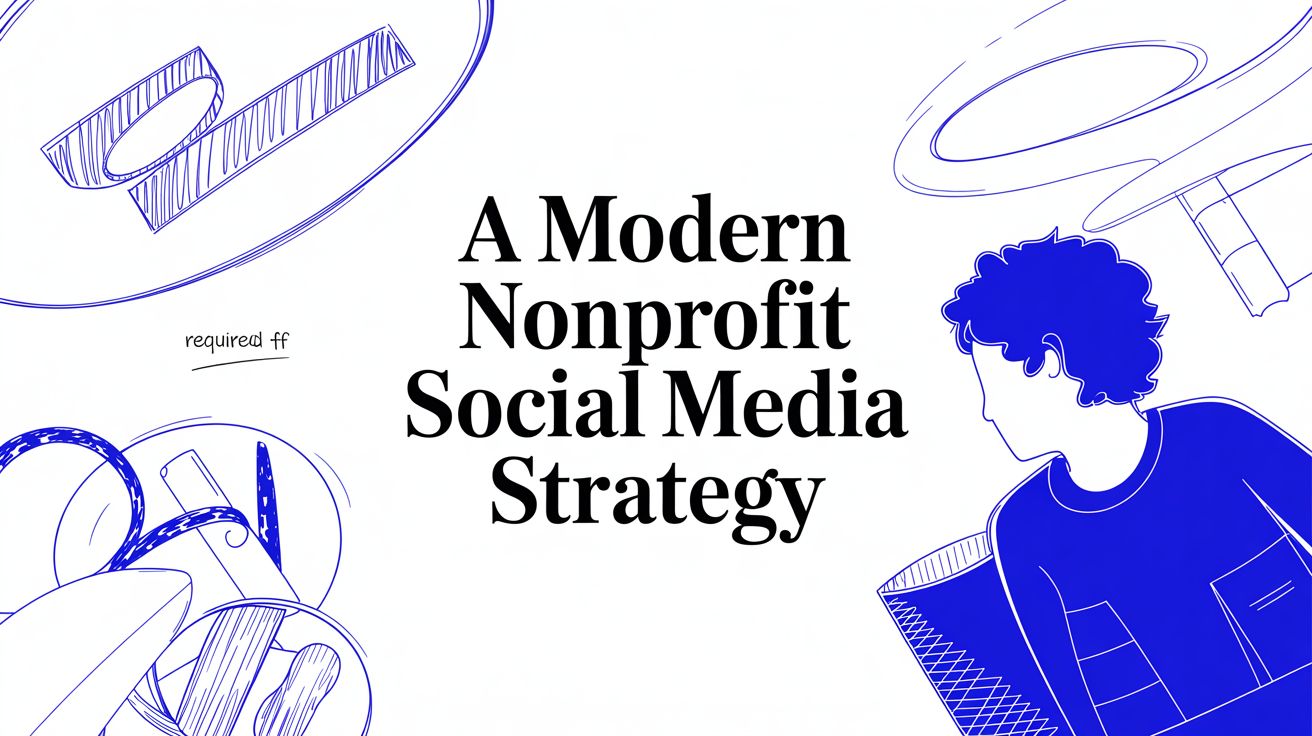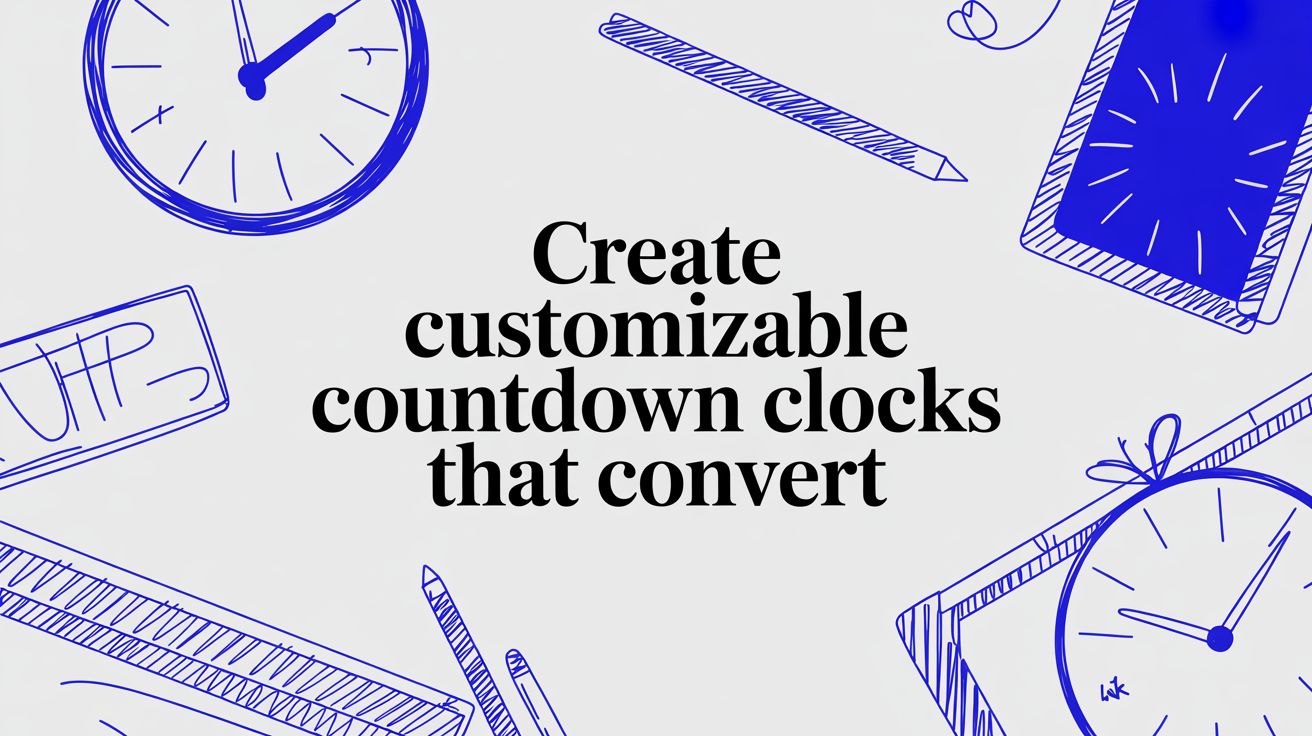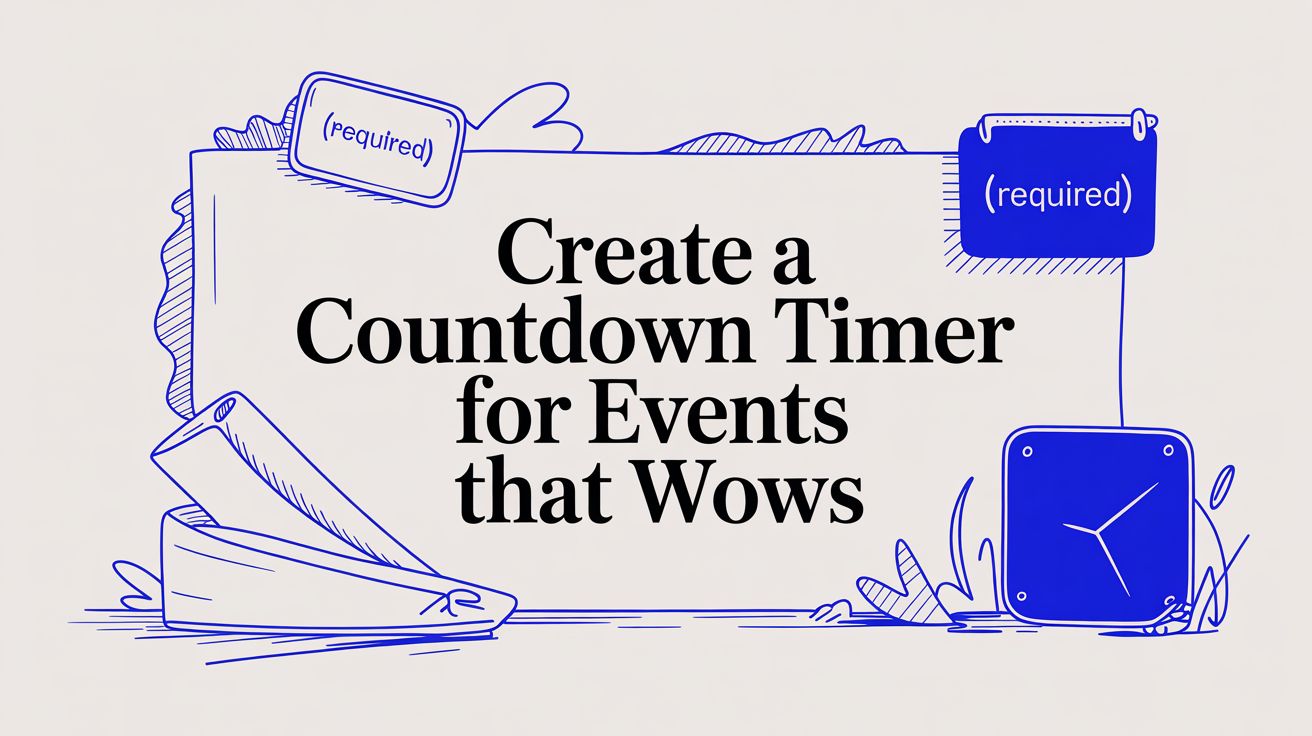How to Increase Brand Awareness Today
A practical guide on how to increase brand awareness. Learn proven strategies across content, social media, SEO, and partnerships to grow your reach.
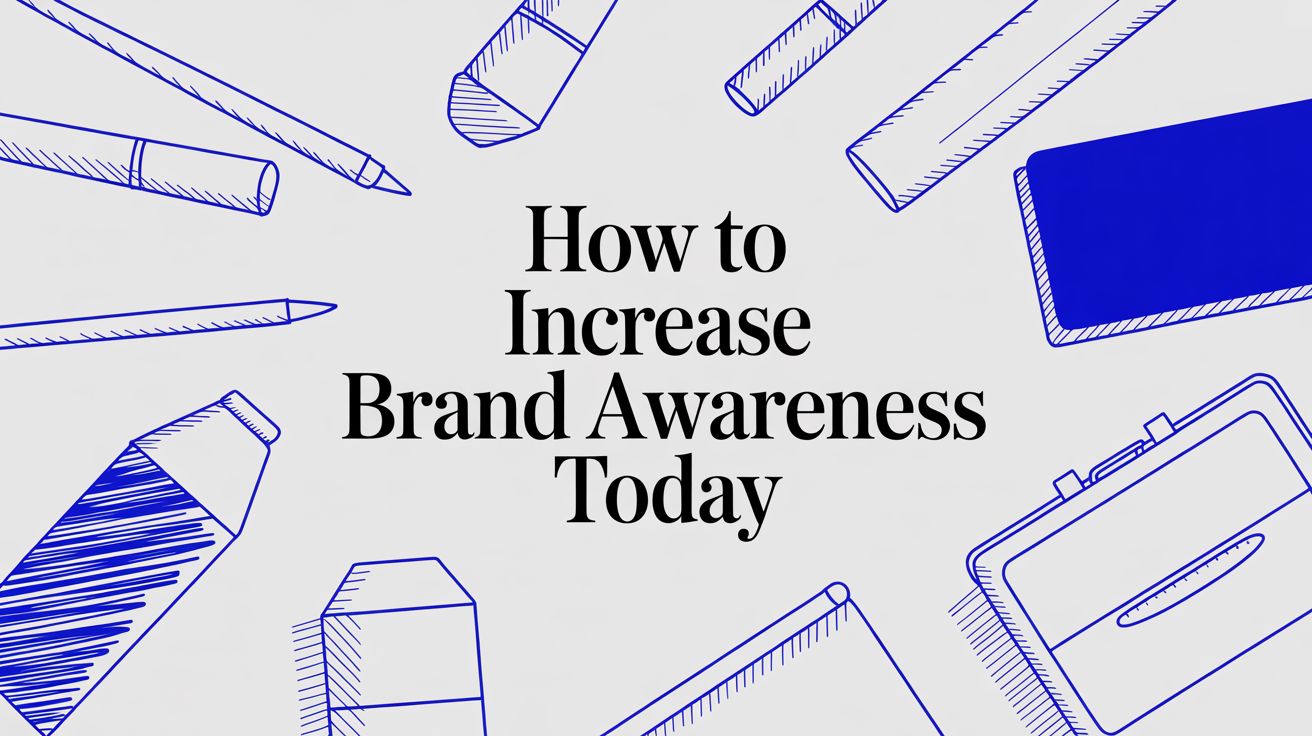
Before you can even think about boosting brand awareness, you have to get your own house in order. That means building a brand identity that’s both memorable and rock-solid. This is all about nailing down your core mission, getting crystal clear on who you’re talking to, and creating a unique voice that feels right, no matter where people find you. A strong foundation is everything—it’s what makes people not only notice you but actually remember you.
Build a Brand People Remember
Long before you launch that first ad or craft a single social media post, the real work begins. Too many businesses think branding is just picking a logo and a few colors. Sure, that's part of it, but those are just the shiny objects that come after you’ve done the deep strategic thinking. Real brand awareness grows from a clear, consistent identity. If you don't know who you are, how can you expect anyone else to?
This first stage is all about your "why." What's your company's mission? And I mean, go deeper than just the products you sell. Are you here to make complicated things simple? To spark creativity? To build a community? This mission is your north star, the thing that guides every single decision from here on out.
Define Your Unique Position in the Market
Once you know your mission, you have to figure out who you're talking to. Creating detailed buyer personas isn't just some fluffy marketing exercise; it’s about putting a human face on your audience. What are their daily struggles? What do they dream about? Where do they hang out online? A brand trying to connect with Gen Z on TikTok is going to sound completely different from one targeting executives on LinkedIn.
Your unique value proposition (UVP) is what you find at the intersection of what your audience desperately needs and what you do better than anyone else. Ask yourself these tough questions:
- What specific problem do we solve better than the competition?
- What emotional payoff do customers get when they choose us?
- Why should they trust us over all the other options out there?
Answering these helps you carve out your own space in a noisy market. It’s the difference between being "just another software company" and "the only software that gives small business owners their weekends back." To really set a strong foundation, digging into potent brand awareness strategies can give you a clear roadmap.
Craft a Consistent Brand Voice and Story
With your mission and audience locked in, it’s time to give your brand a personality. Your brand voice is how that identity comes to life with words. Are you witty and informal? Or are you more authoritative and buttoned-up? Whatever you choose, you have to stick with it everywhere—from your website copy and email newsletters to how you reply to comments on social media.
For instance, a fintech app for millennials might go for a friendly, encouraging, and maybe even a little humorous tone. A B2B cybersecurity firm? They’ll lean into a more formal, reassuring, and expert voice. Consistency is key because it builds familiarity and trust over time. In fact, a 2025 Edelman survey found that 81% of consumers say they have to trust a brand before they'll even consider buying from it. That’s a powerful link between a consistent identity and the bottom line. You can see more on the connection between brand trust and purchase decisions in the full report.
A brand is no longer what we tell the consumer it is—it is what consumers tell each other it is. Your brand story provides the narrative for them to share.
Your story should weave together your mission, your values, and the big problem you solve for customers. It’s not just a boring corporate history; it's an emotional hook that helps people connect with your purpose. Just look at a brand like Patagonia. Their story isn't just about selling jackets. It's about environmental activism and a deep love for the planet—a narrative that their audience connects with on a whole other level. Nailing down this voice is a huge part of great marketing, and you can learn more by exploring our guide to social media marketing best practices.
Amplify Your Voice Across Digital Channels
Alright, you've built a solid brand foundation. Now it's time to get the word out. Your online presence is hands-down the most powerful tool for finding new audiences and turning casual browsers into dedicated fans. But this isn't about just making noise; it's about amplifying your voice where it will actually be heard.
Think of it as a coordinated effort. You need to show up when people are looking for answers (that's SEO), be part of the conversation when they're scrolling (social media), and build credibility through smart partnerships. Each channel has a specific job to do in getting your brand recognized.
The image below breaks down the key parts of a strong brand foundation—the stuff you absolutely need locked in before you start shouting from the rooftops.
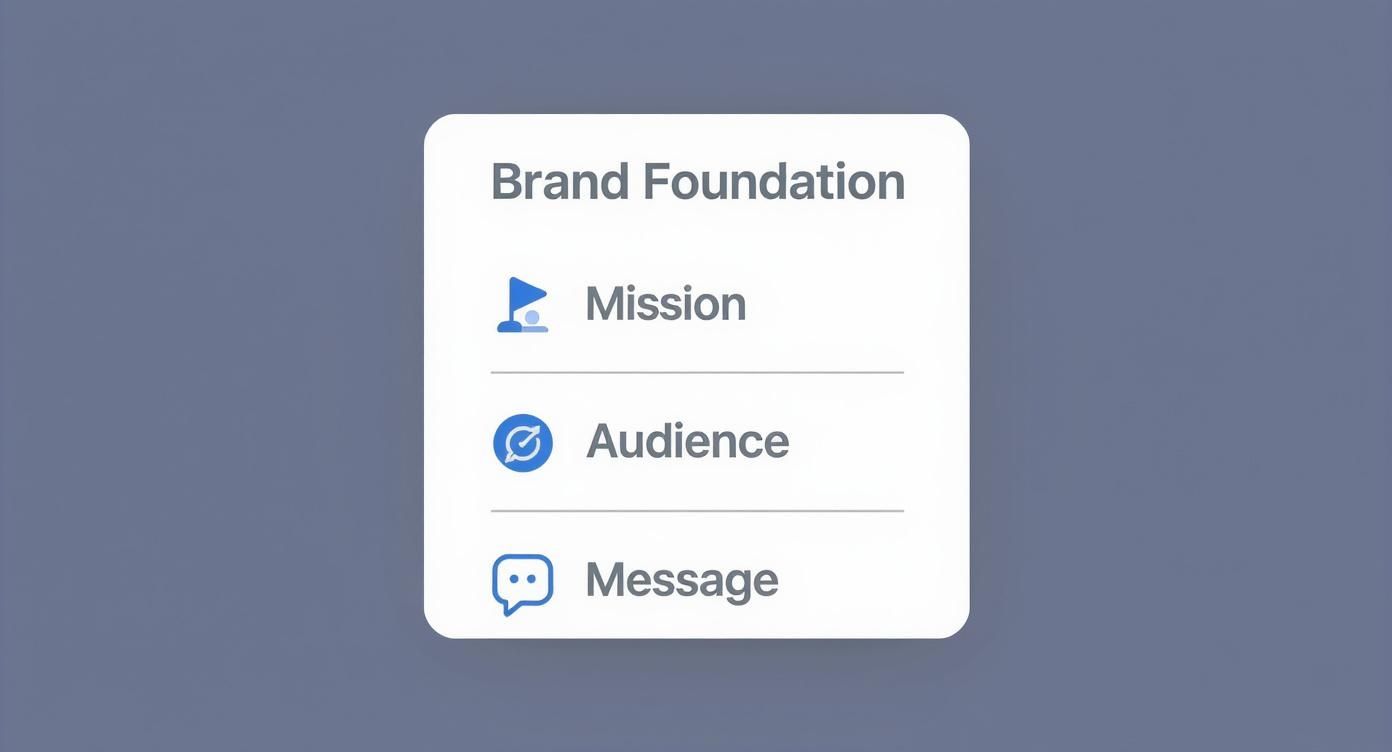
This really nails the connection between your mission, your audience, and your message. When these three things are in sync, every piece of content you push out feels consistent and actually makes an impact.
To help you decide where to focus your energy first, here’s a quick comparison of the most common digital channels.
Digital Channel Strategy Comparison
Each digital channel offers a unique way to connect with your audience. Choosing the right mix depends on who you're trying to reach and what you want to achieve. This table breaks down the strengths and best uses for each.
| Channel | Primary Strength | Best For Audience | Key Tactic Example | | :--- | :--- | :--- | :--- | | SEO | High-Intent Traffic | Actively searching for solutions | Creating "how-to" guides that solve a specific customer problem. | | Social Media | Community Building | Seeking connection & entertainment | Running an interactive Q&A session on Instagram Stories. | | AI Personalization | Scaled Relevance | Expecting tailored experiences | Using automation to send personalized follow-ups after a purchase. | | Influencer Marketing | Building Trust Quickly | Follows niche creators | Partnering with a micro-influencer for an authentic product review video. |
As you can see, a balanced approach is usually best. You can't just rely on one channel to do all the heavy lifting. Now, let's dig into how to make each one work for you.
Get Found with Smart SEO
Search Engine Optimization (SEO) is how you get discovered when it matters most. When people have a problem, their first move is almost always a Google search. Your job is to be the solution they find waiting for them.
This means creating content that speaks directly to their questions and struggles. Forget the hard sell for a minute and focus on being genuinely helpful. Blog posts, detailed guides, and articles that solve real problems are what build authority and pull in organic traffic.
For example, a sustainable fashion brand could write about "how to build a capsule wardrobe" or "the best eco-friendly fabrics." This move positions them as an expert, not just another shop. By consistently offering value, you earn trust way before anyone thinks about buying.
Build a Real Community on Social Media
Social media isn't a megaphone; it's a conversation. The real goal is to build an engaged community, not just rack up followers. That starts with picking the platforms where your people actually hang out and creating content that fits the vibe.
A B2B software company, for example, is going to get a lot more mileage out of sharing industry insights on LinkedIn. On the other hand, a direct-to-consumer brand selling handmade jewelry will probably kill it with visual storytelling on Instagram.
Want to really pop? Go for interactive content.
- Run Polls and Q&As: Get your audience's opinion. It makes them feel like they're part of the brand.
- Share User-Generated Content: Feature photos and posts from your customers. It's the best kind of social proof.
- Go Live: Host a live video to show what happens behind the scenes or answer questions on the spot.
Dynamic video, in particular, is a game-changer for engagement. If you need some fresh ideas to liven up your feed, check out our guide on social media video marketing for some great tips.
Personalize the Experience with AI
Technology is giving us incredible new ways to connect with people on a much deeper level. Looking ahead to 2025, it’s clear that brand awareness is all about using AI for personalization. A whopping 92% of businesses have already brought AI tools into their marketing, with 88% of marketers using it for things like segmenting their content. This is how brands deliver those super-relevant, data-driven experiences that make customers feel recognized.
AI doesn't replace the human touch; it scales it. Use technology to understand your audience's behavior and deliver the right message at the right moment, making them feel seen and understood.
In this fast-moving space, it's also critical to stay ahead of the curve by mastering LLM brand visibility and AI SEO. This ensures you stay discoverable as search itself continues to evolve.
Use Authentic Influencer Collaborations
Working with influencers can be a fantastic way to build trust and tap into new audiences. But here’s the catch: it has to be authentic. The best partnerships happen when an influencer genuinely clicks with your brand's values.
Skip the one-off sponsored posts and focus on building real, long-term relationships with creators who actually use and love what you sell.
Here are a few ways to do that:
- Co-create content: Team up on a video series or a useful guide that benefits both of your audiences.
- Set up affiliate programs: Give them a commission for sales they drive. It’s a true win-win.
- Send products freely: Gift your product to relevant creators with no strings attached. This often leads to the most honest and organic reviews.
When a recommendation from an influencer feels real, their followers trust it. That trust transfers directly to your brand.
Create Urgency and Drive Action
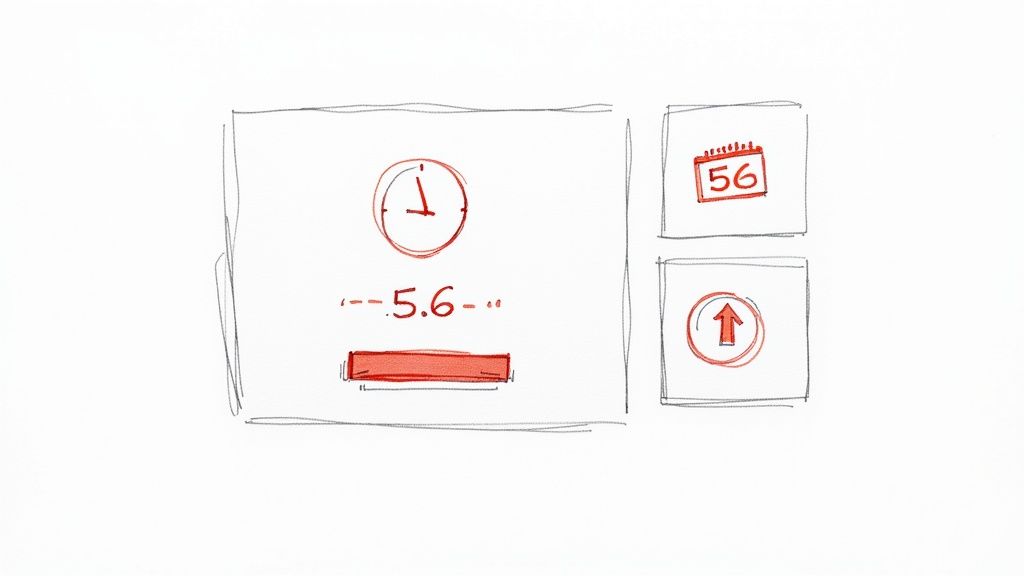
Let's be honest, brand awareness isn't just about getting people to recognize your logo. It's about getting them to act. A powerful way to do that is by creating a sense of urgency. This is the secret sauce that turns a passive scroller into an active participant.
It’s the nudge that transforms "I'll check that out later" into "I need to do this now."
This isn't about cheesy, high-pressure sales tactics. It’s about smartly framing your offers, events, and launches as time-sensitive opportunities. By introducing a deadline or a bit of scarcity, you tap directly into the fear of missing out (FOMO)—a surprisingly effective motivator for boosting immediate interaction with your brand.
Harnessing Urgency for Product Launches
Product launches are the perfect playground for building massive buzz. Instead of just one big announcement, think of it as a rolling thunder of anticipation. A visual countdown timer is your best friend here, serving as a constant, public reminder of what’s coming.
Imagine you're launching a new line of eco-friendly sneakers. You could kick off your campaign weeks in advance:
- Teaser Posts: Start dropping sneak peeks of the new designs on social media, each with a countdown graphic showing "14 Days to Go."
- Email Drip Campaign: Send weekly updates to your subscribers. Each email should feature a live countdown timer ticking down to the big day.
- Website Banner: Slap a prominent countdown timer right on your homepage, pointing everyone to a sign-up page for "early access" notifications.
This builds a shared sense of anticipation. Your audience isn't just watching a date on a calendar; they're watching the clock with you. The timer becomes the visual anchor of your campaign, keeping your brand top-of-mind as launch day gets closer.
The most effective awareness campaigns don't just inform; they create an event. Urgency turns a simple announcement into an experience that people want to be part of, driving both engagement and memory recall.
This entire approach turns your launch from a one-day blip into a sustained brand-building event that racks up shares, comments, and conversations, amplifying your reach along the way.
Driving Action with Limited-Time Offers
For e-commerce brands, limited-time offers are a go-to for driving sales. But they're also fantastic for cranking up brand awareness, especially when you make the deadline impossible to ignore.
A Countdown Timer App is invaluable for this. Let's say you're a small business running a weekend flash sale on your Facebook page. You can publish a post with an auto-updating countdown timer graphic that refreshes every few minutes.
This simple visual cue does a few key things:
- Stops the Scroll: A live, ticking clock is far more dynamic and eye-catching than a static image.
- Encourages Immediate Clicks: Watching time literally slip away prompts people to click your link now instead of telling themselves they'll do it later.
- Boosts Shares: Your followers are much more likely to share a killer deal with friends when they know it's about to disappear.
This strategy works because it makes the consequence of inaction feel real. The abstract idea of a "weekend sale" becomes a very concrete, ticking deadline. For a deeper look at this, our guide on how to create urgency in sales has even more tactics.
Boosting Attendance for Webinars and Events
Getting people to sign up for a webinar is only half the battle. The real challenge? Making sure they actually show up. Urgency is your secret weapon for nailing both registration and attendance.
Here’s a practical workflow you can steal for promoting your next webinar:
- "Early Bird" Registration: Open sign-ups with a special bonus (like a free eBook) for the first 100 people, and promote it with a countdown timer.
- Registration Deadline: A week before the event, launch a "Last Chance to Register" campaign. Use timers in your emails and social posts to hammer home that the deadline is closing in.
- "Event Starts In..." Countdown: In the 24 hours before the event, send out reminder emails with a timer counting down the hours and minutes until go-time.
This multi-layered approach keeps your event from getting lost in the noise. Each countdown acts as a mini-call to action, reinforcing the event's importance and ensuring that when the day arrives, your brand is the one they remember and engage with.
Forge Powerful Connections with Partners and Events
 Let’s be real, true brand awareness goes way beyond just making noise online. It's about building genuine connections that stick, both online and off. This is where strategic partnerships and killer events come in—they’re your ticket to introducing your brand to new, highly relevant audiences in a setting built on trust.
Let’s be real, true brand awareness goes way beyond just making noise online. It's about building genuine connections that stick, both online and off. This is where strategic partnerships and killer events come in—they’re your ticket to introducing your brand to new, highly relevant audiences in a setting built on trust.
While a solid digital game is non-negotiable, these collaborative, real-world efforts add a layer of credibility that a social media post just can't match. When another brand you respect gives you a shout-out, or when you host an event that people are still talking about weeks later, you're not just getting seen. You're building a rock-solid reputation.
Identify and Approach Aligned Brands
Finding the right partner is everything. You're looking for brands that share your vibe and talk to a similar audience, but aren't your direct competitors. The whole point is to tap into a fresh customer base that’s already warmed up to what you do.
Think about it: a fitness apparel brand teaming up with a healthy meal delivery service. It’s a natural fit. Their audiences are both invested in wellness, so the collaboration feels authentic, not forced. It's a classic win-win.
Once you’ve got a list of potential partners, how you reach out makes all the difference. Ditch the generic "let's partner up" email. Seriously, do your homework first.
- Show them you're paying attention: Mention a specific campaign they ran or a piece of content you genuinely loved.
- Bring a real idea to the table: Instead of being vague, suggest something concrete, like a co-hosted webinar on a hot topic or a joint social media giveaway.
- Spell out the "what's in it for them": Clearly explain how they'll benefit. Will they get access to your audience? Will you create amazing content together? Make it a no-brainer for them.
A thoughtful, personalized pitch shows you’re serious and have actually taken the time to understand their brand. Trust me, it makes them way more likely to hit "reply."
Host Branded Events That Provide Real Value
Hosting your own event, whether it's a virtual summit or an in-person workshop, is a power move. It instantly positions your brand as an industry leader. But here's the secret: make it about serving, not selling. An event that's just a thinly veiled sales pitch is a major turn-off.
Instead, create an experience that actually helps people. A digital marketing agency could host a free webinar on "Decoding the Latest Google Algorithm Update." It delivers immediate value, builds trust, and makes the agency the go-to expert people remember.
The best branded events don't just push a product; they build a community. When you create a space for people to learn and connect, you forge positive associations that last.
To really nail the launch, use tools that build anticipation. For something like a virtual summit, a tool like the Countdown Timer App is perfect for creating urgency around registration deadlines or the keynote kickoff. It keeps the event top-of-mind and gets people to sign up before it's too late.
Create Win-Win Cross-Promotional Campaigns
Okay, you've landed a partner. Now the fun part begins. Co-branded content and cross-promotional campaigns are hands-down one of the most effective ways to get your brand in front of a whole new crowd.
Here are a few ideas that just plain work:
- Co-Branded Content: Team up to create an in-depth guide, a research report, or an eBook. Both brands bring their A-game, and both promote it to their audiences. Boom—double the reach.
- Social Media Takeovers: Let your partner take over your Instagram Stories for a day. It’s a fun, low-effort way to give your followers fresh, valuable content from a new perspective.
- Joint Giveaways or Contests: This is a classic for a reason. Run a contest where people have to follow both of your accounts to enter. It’s a super simple and effective tactic for growing both of your audiences at the same time.
At the end of the day, each of these strategies is built on mutual benefit. You get your brand in front of an engaged new audience, and you gain instant credibility by associating with another trusted name. It's a powerful way to grow that feels authentic and genuinely helpful for everyone involved.
Measure What Matters for Brand Growth
If you're not measuring your brand awareness, you can't improve it. It really is that simple. Pouring energy into awesome content, new partnerships, and big campaigns is a huge part of the job, but it’s only half the story. You need a clear way to see what's actually moving the needle.
But this is where a lot of marketers get tripped up. They get hooked on vanity metrics like follower counts or raw page views. Sure, those numbers might give you a temporary ego boost, but they don't tell you if your brand is actually gaining real recognition and influence. To understand your growth, you have to measure what matters.
Moving Beyond Vanity Metrics
The first step is a mental shift. Instead of asking, "How many people saw our post?" start asking, "How did this post change the way people think or act toward our brand?" It’s a subtle change, but it moves you from tracking fleeting attention to measuring lasting impact.
True brand awareness isn't just about eyeballs; it's about recall. It’s about preference. The goal is for your brand to pop into a potential customer's head the moment they have a problem you can solve. That kind of mental real estate is worth way more than a thousand likes on a random post.
So, let's get into the key performance indicators (KPIs) that genuinely show this kind of growth.
- Direct Website Traffic: This is the gold standard. When someone types your URL directly into their browser, it means your brand is top-of-mind. They didn't need Google or a social media link to find you—they already knew exactly who you were.
- Branded Search Volume: This is all about tracking how many people are specifically searching for your brand name or products. A steady climb here is a powerful signal that your awareness efforts are working and people are actively looking for you.
- Social Media Share of Voice: This metric is fantastic because it pits you against the competition. It compares your brand's mentions on social media to those of your direct rivals. A growing share of voice means you're not just part of the conversation; you're starting to lead it.
Tracking the right metrics is like switching from a blurry, outdated map to a high-definition GPS. You stop guessing where you are and start making precise, data-backed decisions that guide your brand exactly where it needs to go.
By zeroing in on these core KPIs, you get a much sharper picture of your brand's health and its real influence in the market.
Tools and Tactics for Effective Monitoring
The good news? You don't have to track all this manually. There are plenty of tools out there that can help you monitor your brand’s presence across the web and social media, giving you the insights you need to tweak and perfect your strategy.
Platforms like Google Analytics are non-negotiable for tracking website traffic sources, especially that all-important direct traffic. For keeping an eye on social conversations, other tools can track brand mentions, analyze sentiment (are people saying good, bad, or neutral things?), and calculate your share of voice automatically.
Here’s a practical way to approach it:
- Set Up Brand Alerts: Use monitoring tools to get instant notifications whenever your brand is mentioned online. This is your chance to jump into conversations in real-time.
- Conduct Regular Audits: Once a quarter, pull reports on your key metrics. Look for the story in the data. Is direct traffic trending up? Is branded search volume growing?
- Analyze the Sentiment: It's not just about how often you're mentioned, but how. A sudden spike in mentions tied to negative customer reviews is a fire you need to put out, not a win for brand awareness.
This simple routine gives you a consistent pulse on how your brand is perceived and helps you spot opportunities—and threats—before they become major issues.
Allocating Your Budget Intelligently
Finally, solid measurement lets you be smarter with your most precious resource: your budget. When you know which channels are driving the most meaningful awareness, you can decide where to double down and where to pull back.
For example, if you see that your podcast collaborations are driving a serious lift in direct traffic and branded searches, you know it's a high-ROI activity worth investing more in. On the flip side, if your paid ads are getting tons of impressions but no corresponding growth in your core awareness KPIs, it might be time to rethink that spend.
Budget allocation is a huge piece of the puzzle. A Nielsen report on 2025 marketing trends shows just how varied the approach is: nearly 24% of marketers prioritize digital ads for awareness, while about 32% still lean on traditional media. The remaining 44% take a more balanced approach.
Ultimately, your own data is your best guide. By measuring what truly matters, you can confidently allocate your resources, prove the value of your work, and build a brand that doesn't just get noticed but becomes unforgettable.
Burning Questions About Brand Awareness
When you're diving into the world of brand awareness, a few key questions always pop up. Let's get them answered so you can move forward with confidence.
How Long Does This Actually Take?
Look, building brand awareness is a marathon, not a sprint. Anyone who tells you otherwise is selling something. While you might get some exciting early signals—like a jump in social media engagement in a few weeks—true, meaningful brand recognition often takes six months to a year of consistent work.
The goal isn't just a fleeting moment in the spotlight. You're building lasting trust and recall, and that just takes time. Real awareness is when someone has a problem you can solve, and your brand is the first thing that pops into their head. Patience is part of the strategy.
What's the Best Tactic if My Budget is Tight?
When you're working with a shoestring budget, organic content marketing is your superpower. Seriously. Forget expensive ads for a moment and focus on creating genuinely helpful, SEO-optimized content. Think blog posts or video guides that solve your audience's most painful problems. This approach builds authority and a loyal community without draining your bank account.
Pair that with real, authentic engagement on one or two social platforms—wherever your people actually hang out.
Don't try to be everywhere. It's a classic mistake. Instead, dominate the one or two channels that matter most to your audience. You'll see a much bigger impact than if you spread yourself too thin across every platform out there. That focus is the secret to getting results without a massive budget.
How Can I Prove This is Actually Working?
Measuring brand awareness isn't as clean as tracking a direct sale, but you can absolutely prove its ROI. It’s all about looking at the right signals that show your influence is growing.
Keep a close eye on a few key metrics that tell the real story:
- Direct Traffic: Are more people typing your website URL straight into their browser? That's a huge win and a clear sign of brand recall.
- Branded Search Volume: You can use tools to see how many people are specifically searching for your brand name. If that number is climbing, it means people are actively looking for you.
- Share of Voice: How often is your brand being mentioned online compared to your top competitors? A rising share means you're not just part of the conversation—you're starting to lead it.
When you see an upward trend in these areas, you have concrete proof that your investment is paying off and your brand's footprint is expanding.
Ready to create that crucial sense of urgency for your next launch or event? Countdown Timer App makes it simple to add auto-updating countdowns to your Facebook page and website, turning passive viewers into active participants. Start building excitement today with our free plan.

